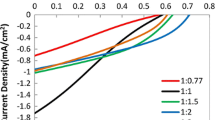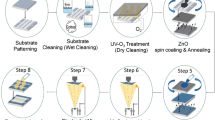Abstract
High boiling point solvent additive, employed during the solution processing of active layer fabrications, impact the efficiency of bulk heterojunction polymer solar cells (PSC) by influencing the morphological of the active layer. The photovoltaic performances of the PSCs based on the donor of poly{4,8-bis[(2-ethylhexyl)oxy]benzo[1,2-b:4,5-b′]-dithiophene-2,6-diyl-alt-3-fluoro-2-[(2 ethylhexyl)carbonyl] thieno[3,4-b]thiophene-4,6-diy (PTB7) and the acceptor of [6, 6]-phenyl-C71-butyric-acidmethyl-ester (PC71BM) was optimized using 5 vol% high-boiling-point solvent additive of 2-Bromonaphthalene (BN). The optimized air-processed PSC based on PTB7:PC71BM (1:1.5 w/w) with 5 vol% BN exhibited a power conversion efficiency of 7.01% with open-circuit voltage (V oc) of 0.731 V, short-circuit current density (J sc) of 13.79 mA cm−2, and fill factor (FF) of 69.46%. The effects of the additive on photovoltaic performances were illustrated with atomic force microscopy and transmission electron microscope measurements. Our results indicate that the improved efficiency is due to the optimized PTB7/PC71BM interpenetrating network and the enhanced absorption of the active layer using the BN as solvent additive.






Similar content being viewed by others
References
Szarko JM, Guo J, Liang Y, Lee B, Rolczynski BS, Strzalka J, Xu T, Loser S, Marks TJ, Yu L (2010) When function follows form: effects of donor copolymer side chains on film morphology and BHJ solar cell performance. Adv Mater 22:5468–5472
Lu L, Zheng T, Wu Q, Schneider AM, Zhao D, Yu L (2015) Recent advances in bulk heterojunction polymer solar cells. Chem Rev 115:12666–12731
Krebs FC, Gevorgyan SA, Alstrup J (2009) A roll-to-roll process to flexible polymer solar cells: model studies, manufacture and operational stability studies. J Mater Chem 19:5442–5451
Li C, Liu M, Pschirer NG, Baumgarten M, Müllen K (2010) Polyphenylene-based materials for organic photovoltaics. Chem Rev 110:6817–6855
Dennler G, Scharber MC, Brabec CJ (2009) Polymer-fullerene bulk-heterojunction solar cells. Adv Mater 21:1323–1338
Forrest SR (2004) The path to ubiquitous and low-cost organic electronic appliances on plastic. Nature 428:911–918
Zeng W, Song G, Li Y, Yuan C, Fan T, Tang W, Wang J, Zhao C, Lai W, Zhang H (2016) Enhanced performance of poly (3-hexylthiophene-2, 5-diyl):[6, 6]-phenyl-C61-butyric acid methyl ester solar cells by UV irradiation. Thin Solid Films 600:136–141
Zhou Y, Shim JW, Fuentes-Hernandez C, Khan TM, Kippelen B (2014) Inverted organic solar cells with polymer-modified fluorine-doped tin oxide as the electron-collecting electrode. Thin Solid Films 554:54–57
Qi L, Zhang C, Chen Q (2014) Performance improvement of inverted organic solar cells by adding ultrathin Al2O3 as an electron selective layer and a plasma enhanced chemical vapor deposition of SiO x encapsulating layer. Thin Solid Films 567:1–7
He Z, Xiao B, Liu F, Wu H, Yang Y, Xiao S, Wang C, Russell TP, Cao Y (2015) Single-junction polymer solar cells with high efficiency and photovoltage. Nat Photonics 9:174–179
Zhao J, Li Y, Yang G, Jiang K, Lin H, Ade H, Ma W, Yan H (2016) Efficient organic solar cells processed from hydrocarbon solvents. Nat Energy 1:15027
Etxebarria I, Ajuria J, Pacios R (2015) Solution-processable polymeric solar cells: a review on materials, strategies and cell architectures to overcome 10%. Org Electron 19:34–60
Vohra V, Kawashima K, Kakara T, Koganezawa T, Osaka I, Takimiya K, Murata H (2015) Efficient inverted polymer solar cells employing favourable molecular orientation. Nat Photonics 9:403–408
Ma W, Yang C, Gong X, Lee K, Heeger AJ (2005) Thermally stable, efficient polymer solar cells with nanoscale control of the interpenetrating network morphology. Adv Funct Mater 15:1617–1622
Yang X, Loos J, Veenstra SC, Verhees WJ, Wienk MM, Kroon JM, Michels MA, Janssen RA (2005) Nanoscale morphology of high-performance polymer solar cells. Nano Lett 5:579–583
Li G, Shrotriya V, Huang J, Yao Y, Moriarty T, Emery K, Yang Y (2005) High-efficiency solution processable polymer photovoltaic cells by self-organization of polymer blends. Nat Mater 4:864–868
Li G, Yao Y, Yang H, Shrotriya V, Yang G, Yang Y (2007) “Solvent annealing” effect in polymer solar cells based on poly (3-hexylthiophene) and methanofullerenes. Adv Funct Mater 17:1636–1644
Fukuda T, Toda A, Takahira K, Suzuki K, Liao Y, Hirahara M, Saito M, Osaka I (2016) Molecular ordering of spin-coated and electrosprayed P3HT: PCBM thin films and their applications to photovoltaic cell. Thin Solid Films 612:373–380
Wu FC, Li YH, Tsou CJ, Tung KC, Yen CT, Chou FS, Tang FC, Chou WY, Ruan J, Cheng HL (2015) Synergistic effects of binary-solvent annealing for efficient polymer-fullerene bulk heterojunction solar cells. ACS Appl Mater Interfaces 7:18967–18976
Wang D, Zhang F, Li L, Yu J, Wang J, An Q, Tang W (2014) Tuning nanoscale morphology using mixed solvents and solvent vapor treatment for high performance polymer solar cells. RSC Adv 4:48724–48733
Moon JS, Takacs CJ, Sun Y, Heeger AJ (2011) Spontaneous formation of bulk heterojunction nanostructures: multiple routes to equivalent morphologies. Nano Lett 11:1036–1039
Wang DH, Moon JS, Seifter J, Jo J, Park JH, Park OO, Heeger AJ (2011) Sequential processing: control of nanomorphology in bulk heterojunction solar cells. Nano Lett 11:3163–3168
Peet J, Kim JY, Coates NE, Ma WL, Moses D, Heeger AJ, Bazan GC (2007) Efficiency enhancement in low-bandgap polymer solar cells by processing with alkane dithiols. Nat Mater 6:497–500
Yao Y, Hou J, Xu Z, Li G, Yang Y (2008) Effects of solvent mixtures on the nanoscale phase separation in polymer solar cells. Adv Funct Mater 18:1783–1789
Moon JS, Takacs CJ, Cho S, Coffin RC, Kim H, Bazan GC, Heeger AJ (2010) Effect of processing additive on the nanomorphology of a bulk heterojunction material†. Nano Lett 10:4005–4008
Demeshko S, Dechert S, Meyer F (2004) Anion-π interactions in a carousel copper (II)-triazine complex. J Am Chem Soc 126:4508–4509
Schottel BL, Chifotides HT, Dunbar KR (2008) Anion-π interactions. Chem Soc Rev 37:68–83
Chaban VV, Maciel C, Fileti EE (2014) Does the like dissolves like rule hold for fullerene and ionic liquids? J Solut Chem 43:1019–1031
Hedley GJ, Ward AJ, Alekseev A, Howells CT, Martins ER, Serrano LA, Cooke G, Ruseckas A, Samuel ID (2013) Determining the optimum morphology in high-performance polymer-fullerene organic photovoltaic cells. Nat Commun 4:1–10
Liu X, Huettner S, Rong Z, Rong Z, Sommer M, Friend RH (2012) Solvent additive control of morphology and crystallization in semiconducting polymer blends. Adv Mater 24:669–674
van Duren JK, Yang X, Loos J, Bulle-Lieuwma CW, Sieval AB, Hummelen JC, Janssen RA (2004) Relating the morphology of poly (p-phenylene vinylene)/methanofullerene blends to solar-cell performance. Adv Funct Mater 14:425–434
Shaheen SE, Brabec CJ, Sariciftci NS, Padinger F, Fromherz T, Hummelen JC (2001) 2.5% efficient organic plastic solar cells. Appl Phys Lett 78:841–843
Hoppe H, Glatzel T, Niggemann M, Schwinger W, Schaeffler F, Hinsch A, Lux-Steiner MC, Sariciftci N (2006) Efficiency limiting morphological factors of MDMO-PPV: PCBM plastic solar cells. Thin Solid Films 511:587–592
Padinger F, Rittberger RS, Sariciftci NS (2003) Effects of postproduction treatment on plastic solar cells. Adv Funct Mater 13:85–88
Kim Y, Cook S, Tuladhar SM, Choulis SA, Nelson J, Durrant JR, Bradley DD, Giles M, McCulloch I, Ha C-S (2006) A strong regioregularity effect in self-organizing conjugated polymer films and high-efficiency polythiophene: fullerene solar cells. Nat Mater 5:197–203
Zhang F, Jespersen KG, Björström C, Svensson M, Andersson MR, Sundström V, Magnusson K, Moons E, Yartsev A, Inganäs O (2006) Influence of solvent mixing on the morphology and performance of solar cells based on polyfluorene copolymer/fullerene blends. Adv Funct Mater 16:667–674
Chen LM, Hong Z, Li G, Yang Y (2009) Recent progress in polymer solar cells: manipulation of polymer: fullerene morphology and the formation of efficient inverted polymer solar cells. Adv Mater 21:1434–1449
Hoven CV, Dang XD, Coffin RC, Peet J, Nguyen TQ, Bazan GC (2010) Improved performance of polymer bulk heterojunction solar cells through the reduction of phase separation via solvent additives. Adv Mater 22:E63–E66
Lee JK, Ma WL, Brabec CJ, Yuen J, Moon JS, Kim JY, Lee K, Bazan GC, Heeger AJ (2008) Processing additives for improved efficiency from bulk heterojunction solar cells. J Am Chem Soc 130:3619–3623
Pivrikas A, Stadler P, Neugebauer H, Sariciftci NS (2008) Substituting the postproduction treatment for bulk-heterojunction solar cells using chemical additives. Org Electron 9:775–782
Moulé AJ, Meerholz K (2008) Controlling morphology in polymer–fullerene mixtures. Adv Mater 20:240–245
Liang Y, Xu Z, Xia J, Tsai ST, Wu Y, Li G, Ray C, Yu L (2010) For the bright future—bulk heterojunction polymer solar cells with power conversion efficiency of 7.4%. Adv Mater 22:135–138
Guo X, Cui C, Zhang M, Huo L, Huang Y, Hou J, Li Y (2012) High efficiency polymer solar cells based on poly (3-hexylthiophene)/indene-C70 bisadduct with solvent additive. Energy Environ Sci 5:7943–7949
Turro NJ, Bolt JD, Kuroda Y, Tabushi I (1982) A study of the kinetics of inclusion of halonaphthalenes with ß-cyclodextrin via time correlated phosphorescence. Photochem Photobiol 35:69–72
Sun X, Ni J, Li C, Huang L, Xu R, Li Z, Cai H, Li J, Zhang J (2016) Air-processed high performance ternary blend solar cell based on PTB7-Th: PCDTBT: PC70BM. Org Electron 37:222–227
Kim W, Kim JK, Kim E, Ahn TK, Wang DH, Park JH (2015) Conflicted effects of a solvent additive on PTB7: PC71BM bulk heterojunction solar cells. J Phys Chem C 119:5954–5961
Huo L, Liu T, Sun X, Cai Y, Heeger AJ, Sun Y (2015) Single-junction organic solar cells based on a novel wide-bandgap polymer with efficiency of 9.7%. Adv Mater 27:2938–2944
Liu F, Zhao W, Tumbleston JR, Wang C, Gu Y, Wang D, Briseno AL, Ade H, Russell TP (2014) Understanding the morphology of PTB7: PCBM blends in organic photovoltaics. Adv Energy Mater 4:1301377
Hendriks KH, Heintges GH, Gevaerts VS, Wienk MM, Janssen RA (2013) High-molecular-weight regular alternating diketopyrrolopyrrole-based terpolymers for efficient organic solar cells. Angew Chem Int Ed 52:8341–8344
Li W, Hendriks KH, Furlan A, Roelofs WC, Wienk MM, Janssen RA (2013) Universal correlation between fibril width and quantum efficiency in diketopyrrolopyrrole-based polymer solar cells. J Am Chem Soc 135:18942–18948
Acknowledgements
This work was supported by National Natural Science Foundation of China (Grant No. 61377031) and the National Natural Science Foundation of China (No. 61404073).
Author information
Authors and Affiliations
Corresponding authors
Rights and permissions
About this article
Cite this article
Sun, X., Li, C., Huang, L. et al. Effects of high-boiling-point additive 2-Bromonaphthalene on polymer solar cells fabricated in ambient air. Polym. Bull. 74, 4515–4524 (2017). https://doi.org/10.1007/s00289-017-1971-9
Received:
Revised:
Accepted:
Published:
Issue Date:
DOI: https://doi.org/10.1007/s00289-017-1971-9




